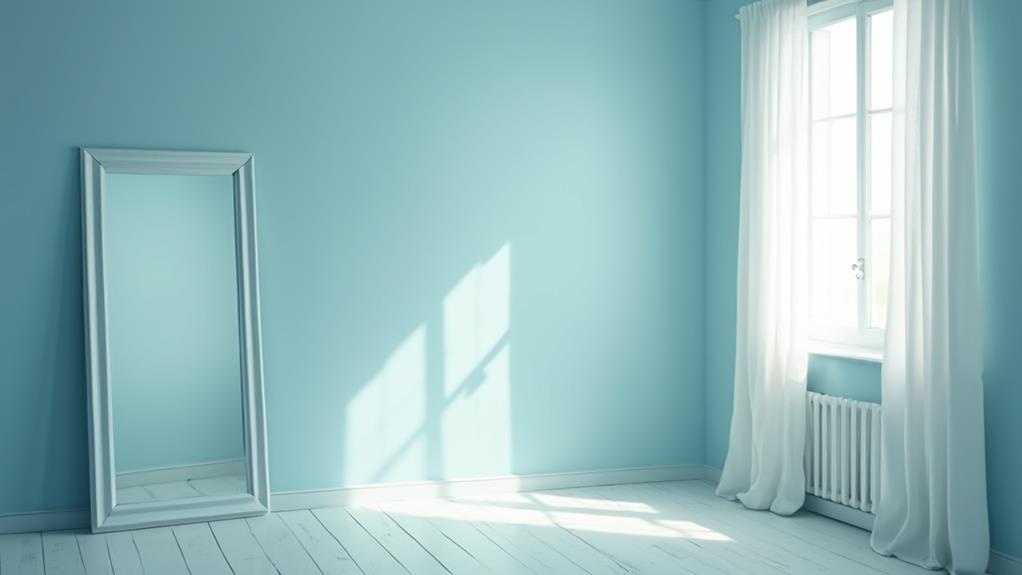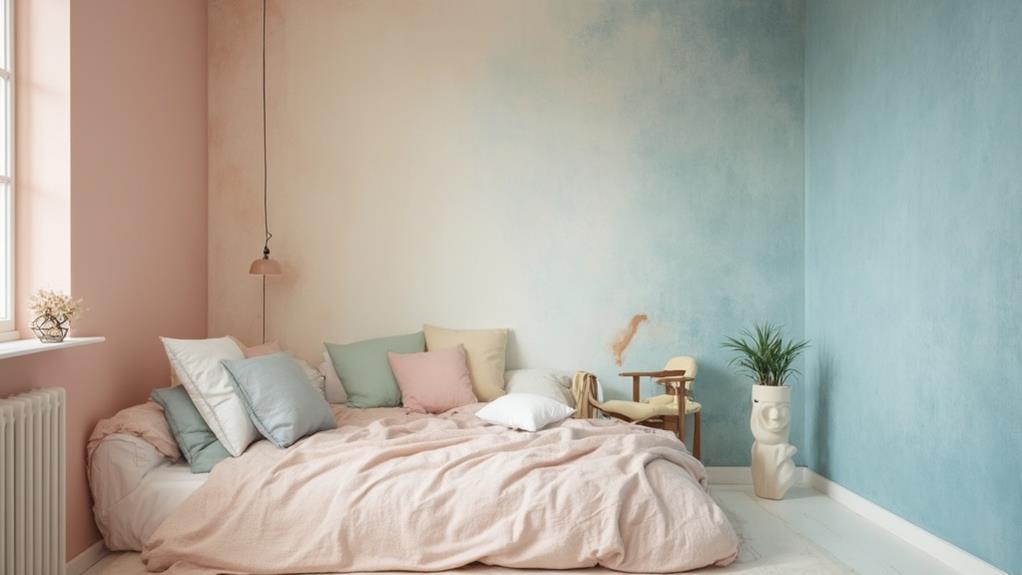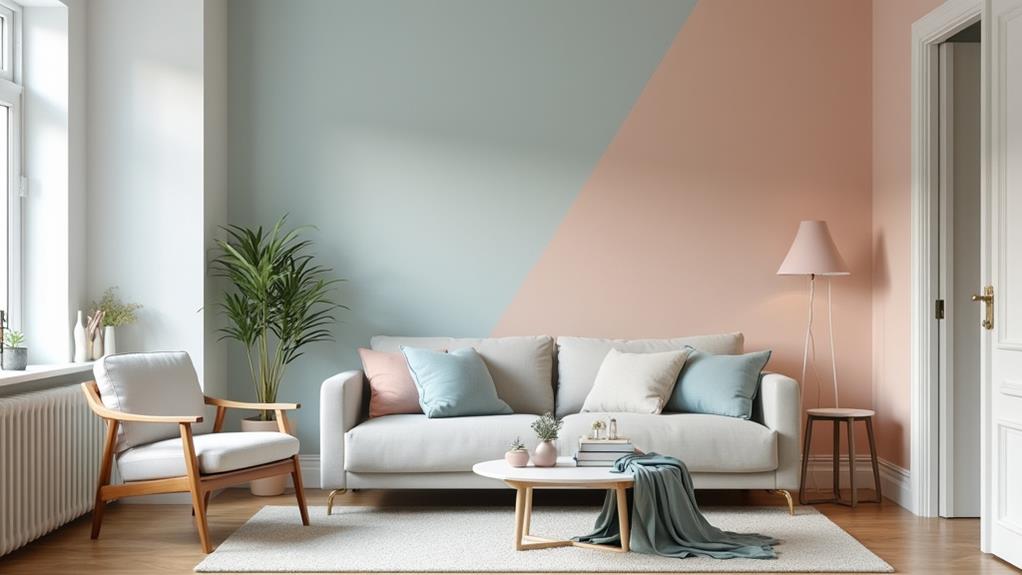Small rooms adore light, neutral, and dark colors for good reason. These shades leverage color psychology, playing with light absorption and reflection to give your room that spacious feel you crave. You'll find lighter hues and neutrals make a room feel open and airy, while specific dark colors can add depth without confining the space. It's also about the mood. Calm blues, uplifting yellows, or cozy dark tones — it's all about creating the ambiance you desire. Ready to pick that perfect palette? There's plenty more tips and insights waiting, just a scroll away.
Exploring Color Psychology

Often, we overlook the powerful influence color can have on our mood and mindset. It's not just about aesthetics; color psychology plays an essential role in how we perceive and interact with spaces.
As you immerse yourself in the world of interior design, understanding this science can help you make informed decisions.
Imagine you're in a small room painted black. How does it feel? Probably oppressive, maybe even a bit claustrophobic. That's because darker colors tend to absorb light, making spaces feel smaller and more confined.
Now, picture the same room painted white. It likely feels larger, brighter, and more open. This is due to the fact that lighter colors reflect light, creating an illusion of more space.
However, it's not only about size perception. Colors also provoke emotional responses. Reds can evoke feelings of warmth and passion but can also be intense and energizing.
Blues might make you feel calm and relaxed, while yellows could uplift your mood. So, when you're choosing colors for a small room, consider not only the physical effect but also the emotional impact.
Benefits of Light Colors in Small Rooms

Light colors can work wonders in a small room, transforming it from a cramped, dark space into a bright and airy haven.
They're not just a design choice, they offer functional benefits that can drastically improve your perception of a small space.
Here are some reasons why you should consider light colors for small rooms:
- Perceived Space: Light colors reflect more light, making your room seem larger than it is. You'll feel like you've gained square footage without moving a wall!
- Brightness: Light colors can effectively brighten a room, reducing the need for additional lighting and saving you on electricity bills.
- Versatility: Light colors provide a neutral backdrop that allows you to play with your décor without worrying about clashing colors.
- Mood Enhancement: Light colors are known to uplift moods and induce a feeling of calmness and serenity.
Dark Colors: Small Rooms Unexpected Ally

While light colors have their undeniable benefits in small spaces, don't discount the power of dark hues as an unexpected ally. It may seem counterintuitive at first, but dark colors can add depth and dimension to petite rooms. They make your walls recede, creating an illusion of more space.
Imagine your small room as a jewel box, and consider dark colors as the velvet lining that enhances its charm. Deep blues, rich purples, or even bold blacks can create a cozy, intimate atmosphere. They provide a dramatic backdrop against which your furniture and décor can pop.
But, there's a catch. You've got to balance these dark shades with the right lighting and accents. A well-placed lamp or a strategically hung mirror can amplify the room's light, preventing it from feeling cramped.
Your room's size isn't the enemy here; it's how you use color to manipulate perception.
Neutral Colors for Spacious Perception

You might be surprised to learn how neutral colors can transform your small room into a seemingly spacious area. Neutral colors aren't as plain or boring as you might think. They've a unique ability to open up a room, creating a sense of spaciousness and light.
Here are four reasons why neutral colors work magic in a small room:
- Light Reflection: Neutrals reflect light, making your room appear brighter and larger. The contrast between dark and light is what makes spaces seem smaller or larger.
- Simplicity: Neutral colors simplify a room. They don't distract the eye, which can make a room feel cluttered and small.
- Versatility: Neutrals work with any style or theme. They're like a blank canvas that you can dress up or down as you like, without making the room feel cramped.
- Illusion of Continuity: Using the same neutral color throughout a room can make it seem larger because there's no interruption to the eye.
Color Impact on Room Size Perception

Nearly every color has a hidden power: it has the ability to alter our perception of a room's size. You mightn't realize it, but the colors you choose can make a room seem larger or smaller.
Light colors, for example, can make a small room seem larger and more open. They reflect light and create a sense of space. Soft tones of white, beige, or pastels are excellent choices for small rooms. They're like a blank canvas, allowing your furniture and decor to take center stage.
On the other hand, dark colors tend to absorb light, making rooms feel smaller and cozier. If you're looking to create a snug, intimate space, consider shades like navy, burgundy, or forest green.
But, be careful. Overuse of dark colors can make a room feel cramped, not cozy.
Achieving Cohesiveness Through Color Matching

To create a harmonious and balanced aesthetic in your small room, consider the art of color matching. It's not just about your favorite shades, it's about how the colors work together to create a cohesive feel. Let's explore a few key tips to help you master this art.
1. Identify a Base Color: Start with one primary color that you love. This will be the base for your color scheme and should ideally be a color that you won't tire of quickly.
For example, a statement sofa in a bold color can set the tone for the entire room.
2. Find Complementary Colors: Use a color wheel to identify colors that complement your base color. These can create a vibrant contrast and prevent your room from feeling monotonous.
Consider how textiles like throws and cushions can introduce complementary colors effortlessly.
3. Consider the Undertones: Most colors have undertones that can impact how they look when paired together.
For instance, a blue with a green undertone can look off next to a pure blue. So, always consider undertones when matching colors.
4. Test Before Committing: Always test your color choices in the room before you commit.
Light can dramatically change how a color looks, so it's important to see how it looks in your space at different times of the day.
Personalized Color Schemes for Home Makeover

Building on the art of color matching, let's personalize your space with a unique color scheme that reflects your tastes and lifestyle. Don't be afraid to push boundaries – it's your space, after all.
First, consider your favorite colors. What tones make you feel comfortable, relaxed, or energized? Those are great starting points. But don't just slap them all on the wall. You've got to balance them. Cool colors can make a room feel spacious, while warm colors can make it feel cozy.
Try to mix and match until you've got a blend that feels right.
Next, consider your furniture and decor. What colors are they? Can you tie them into your color scheme? It's not a must, but it can create a more cohesive look.
Finally, remember the light. Natural daylight can make a color look different than artificial light. So think about when you'll be using the room most and choose your colors accordingly.
Personalizing your color scheme isn't just about aesthetics. It's about creating a space that makes you feel good. So take your time, experiment, and have fun with it.

